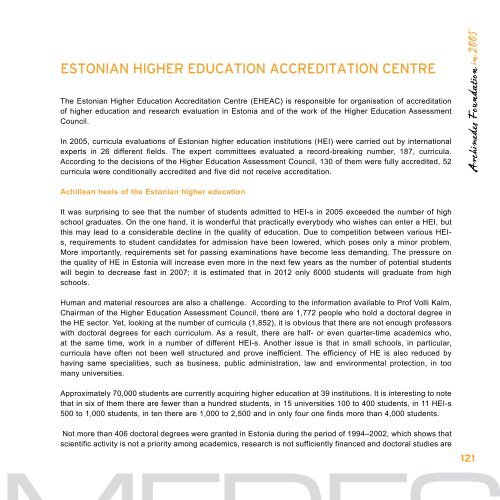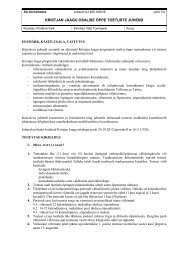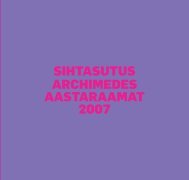SIHTASUTUSE ARCHIMEDES Aastaraamat
SIHTASUTUSE ARCHIMEDES Aastaraamat
SIHTASUTUSE ARCHIMEDES Aastaraamat
You also want an ePaper? Increase the reach of your titles
YUMPU automatically turns print PDFs into web optimized ePapers that Google loves.
ESTONIAN HIGHER EDUCATION ACCREDITATION CENTRE<br />
The Estonian Higher Education Accreditation Centre (EHEAC) is responsible for organisation of accreditation<br />
of higher education and research evaluation in Estonia and of the work of the Higher Education Assessment<br />
Council.<br />
In 2005, curricula evaluations of Estonian higher education institutions (HEI) were carried out by international<br />
experts in 26 different fields. The expert committees evaluated a record-breaking number, 187, curricula.<br />
According to the decisions of the Higher Education Assessment Council, 130 of them were fully accredited, 52<br />
curricula were conditionally accredited and five did not receive accreditation.<br />
Achillean heels of the Estonian higher education<br />
It was surprising to see that the number of students admitted to HEI-s in 2005 exceeded the number of high<br />
school graduates. On the one hand, it is wonderful that practically everybody who wishes can enter a HEI, but<br />
this may lead to a considerable decline in the quality of education. Due to competition between various HEIs,<br />
requirements to student candidates for admission have been lowered, which poses only a minor problem.<br />
More importantly, requirements set for passing examinations have become less demanding. The pressure on<br />
the quality of HE in Estonia will increase even more in the next few years as the number of potential students<br />
will begin to decrease fast in 2007; it is estimated that in 2012 only 6000 students will graduate from high<br />
schools.<br />
Human and material resources are also a challenge. According to the information available to Prof Volli Kalm,<br />
Chairman of the Higher Education Assessment Council, there are 1,772 people who hold a doctoral degree in<br />
the HE sector. Yet, looking at the number of curricula (1,852), it is obvious that there are not enough professors<br />
with doctoral degrees for each curriculum. As a result, there are half- or even quarter-time academics who,<br />
at the same time, work in a number of different HEI-s. Another issue is that in small schools, in particular,<br />
curricula have often not been well structured and prove inefficient. The efficiency of HE is also reduced by<br />
having same specialities, such as business, public administration, law and environmental protection, in too<br />
many universities.<br />
Approximately 70,000 students are currently acquiring higher education at 39 institutions. It is interesting to note<br />
that in six of them there are fewer than a hundred students, in 15 universities 100 to 400 students, in 11 HEI-s<br />
500 to 1,000 students, in ten there are 1,000 to 2,500 and in only four one finds more than 4,000 students.<br />
Not more than 406 doctoral degrees were granted in Estonia during the period of 1994–2002, which shows that<br />
scientific activity is not a priority among academics, research is not sufficiently financed and doctoral studies are<br />
Archimedes Foundation in 2005<br />
121







